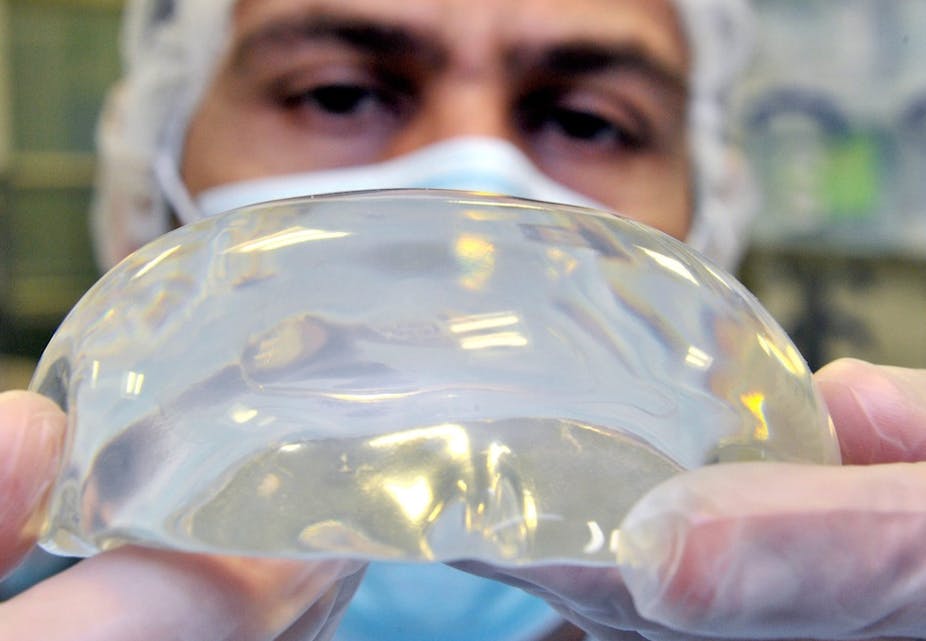The worldwide controversy around the safety of PIP (Poly Implant Prosthèse) breast implants has elicited different responses from governments, despite all of them seemingly acting on the same set of evidence. These responses illustrate how little we have learnt from the debate and worldwide litigation that raged around breast implants in the 1980s and 1990s.
From what has been reported to date, the evidence on adverse outcomes from these implants is weak. So, while the governments of the United Kingdom, France, Germany and the Czech Republic have advised women with PIP implants to have them removed, the Australian government has said there’s no evidence to support their removal.
The problem with the PIP implants arise from the fact that some of them were filled with industrial-grade silicone rather than more expensive, higher quality medical silicone.
Silicones are man-made compounds of silicon, carbon, hydrogen and oxygen. They’re used in cosmetics, to lubricate machinery, in foods and as hydraulic and brake fluid. If breast implants rupture, the silicone can leach into the body and the effects of this leaching is what is in dispute.
In many ways this new controversy is a replay of the Dow Corning scandal of the 1980s and 1990s, so problems linked to silicone breast implants are clearly not new.
Re-living history
Throughout the 1980s and 1990s, a number of class actions were brought against Dow Corning, an American manufacturer of silicone breast implants, in several countries, including Australia. Around 400,000 women worldwide were involved in the class action suits.
Claims linked the implants to breast cancer, autoimmune diseases and neurological problems. Such problems led to protracted legal proceedings in a number of countries, significant public controversy and debate, and the filing for bankruptcy by Dow Corning (the company was re-launched in 2004).
During the debate on the safety of silicone implants, stakeholders took expected positions. While lawyers and doctors acting on behalf of women claiming to have suffered damage from breast implants argued that they were toxic and unsafe, others argued there were no independent scientific data to verify such claims. In particular, those who manufactured the implants, and the doctors who implanted them, claimed that three decades of use proved that silicone implants were safe.
At the same time, the US Food and Drug Administration (FDA), while acknowledging that anecdotal evidence was mounting against silicone implants, found insufficient scientific data to prove any toxic or other adverse effects.
In 1999, the US Institute of Medicine’s Committee on the Safety of Silicone Breast Implants reported that they had found no evidence for silicone breast implants being associated with any disease. But the Safety of Silicone Implants report did note a high incidence of more localised complications, including implant rupture, infection and silicone leaking through the nipple or skin.
Significantly, it expressed concern that women who had silicone breast implants had not been informed about potential risks associated to the implants, and that risk of local complications had been understated.
And here we are, three decades later, facing the same issues about breast augmentation but with a different company producing the implants. Again the company is facing bankruptcy, and again, the response to the issue is confused.
We’re still unsure about the risks of silicone implants, we have failed to gather any robust or systematic evidence about their safety – even though the Therapeutic Goods Administration (TGA) says that in the last 10 years, around 5000 Australian women have received PIP implants. Because we don’t gather data in Australia about who gets what cosmetic procedure, we have little idea of who these women are, who carried out the procedures and whether any of the implants have ruptured. And we have absolutely no idea how many Australian women may have gone abroad, to countries such as Thailand, for their breast implants.
Unlearnt lessons
Clearly, the lesson from the PIP controversy (and the Dow Corning one before it) about the safety of breast implants is that we need better information.
Not only have we failed to systematically gather evidence about the safety of breast augmentation, in Australia, we don’t even know who has implants. If we are to avoid repeating the same mistake in another 20 years we need to gather better evidence, including data on any adverse impacts. We need longitudinal studies of how different breast implants perform, and to do this, we need to know who is getting the implants and who their surgeons are.
Second, women need to be better informed about all potential risks of breast implants, however, small.
It seems we learnt nothing from the Dow Corning scandal but now we have a second chance, one that will also help us start coming to grips with the rapid expansion of the cosmetic surgery implant industry. Otherwise we may be condemning another generation of women to exposing themselves to the unknown risks of breast augmentation.

